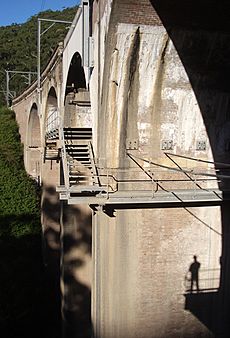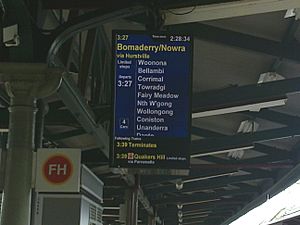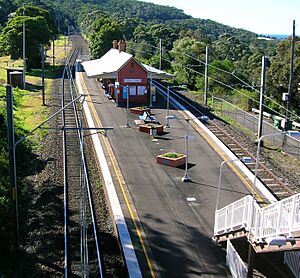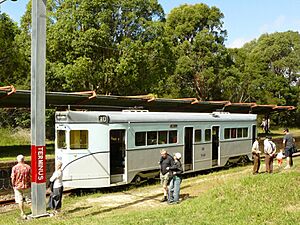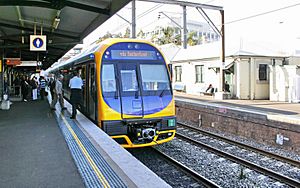South Coast railway line, New South Wales facts for kids
Quick facts for kids South Coast railway line |
|
|---|---|
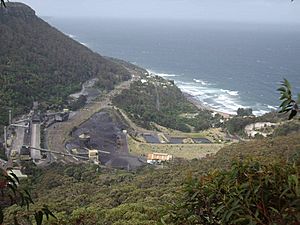
View of the South Coast line as it runs past the Illawarra Coke Company at Coalcliff
|
|
| Overview | |
| Owner | Transport Asset Holding Entity |
| Termini | Illawarra Junction Bomaderry |
| Stations | 56 |
| Service | |
| System | Sydney Trains and NSW TrainLink |
| Operator(s) | NSW TrainLink Sydney Trains Pacific National |
| Rolling stock | H set (OSCAR) T set (Tangara) Endeavour railcars |
| History | |
| Opened | 1887 |
| Technical | |
| Track length | 153 kilometres (95 mi) |
| Track gauge | 1,435 mm (4 ft 8 1⁄2 in) standard gauge |
| Electrification | 1,500 V DC overhead between Illawarra Junction and Kiama |
The South Coast Railway (also known as the Illawarra Railway) is a railway line in New South Wales, Australia. It connects Sydney to Wollongong and Bomaderry. This line is used for both passenger trains and freight trains. It starts at Illawarra Junction and serves the Illawarra and South Coast areas.
The railway line was built in parts between 1884 and 1893. Its main purpose was to help the Coal Cliff Colliery and connect the Illawarra region to Sydney. Later, it also linked the industrial areas at Port Kembla to Sydney's freight network. The line is also important for public transport. It helps people in St George, Sutherland, and Illawarra travel around. The line has 56 stations and is about 153-kilometre (95 mi) long. The NSW government owns it. Sydney Trains and NSW TrainLink run the passenger services.
Contents
History of the South Coast Railway
Building the Line
People first thought about building a railway to the Illawarra area in the 1870s. Railways already existed to the north, west, and southwest of Sydney. A group of important citizens believed a new railway would help farming and mining in the Illawarra.
In 1873, a surveyor named R. Stephens looked for a good route. He found many challenges with the land. It had deep valleys and thick bush. He also noted that trains would need zig-zag tracks to climb the Illawarra escarpment. This first idea was rejected by the government in 1876.
The government approved a new route in 1880. This route is mostly what we see today. It went from Macdonaldtown to Kiama. Construction started in October 1882. The line was finished to Hurstville in 1884 and to Sutherland in 1885. It reached Waterfall in 1886. The line then extended to Clifton, Wollongong, and North Kiama (Bombo) in 1887.
The part between Waterfall and Clifton was difficult to build. It needed many tunnels and bridges. This section opened in 1888. The final part, from Kiama to Bomaderry, opened in 1893.
Making the Tracks Bigger
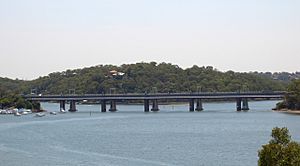
The line first had two tracks near Sydney and then one track further south. But more and more people used the line. So, it needed more tracks. The line was doubled from Hurstville to Loftus Station in 1890. It was then doubled further south to Waterfall. The section near Sydney was made into four tracks between 1913 and 1925.
The old Como bridge over the Georges River was a single track. This caused a traffic jam for trains. A new, wider bridge was built next to it. It opened in 1972. The old bridge is now a path for walking and cycling. Today, two tracks continue all the way to Unanderra.
New Routes and Tunnels
The original railway line had very steep hills. This made it hard for heavy freight trains. Sometimes, trains had to be split into parts to get up the hills. To fix this, a new, less steep route was built. This new route opened in stages between 1914 and 1920. It was longer but much easier for trains. Many stations along the old route were closed or moved.
The old route had several tunnels, known as the Helensburgh Tunnels. These tunnels were built between 1884 and 1886. They were no longer used after the new route opened in 1920. The most famous was the Otford Tunnel. It was very long and filled with smoke and heat. This made it hard for passengers and train crews. People tried to improve it with vents, but it was still a problem.
Old Tunnels and Why They Closed
Here is a list of the old Helensburgh Tunnels:
| Tunnel name | Length | Comments | |
|---|---|---|---|
| m | ft | ||
| Waterfall | 221 | 725 | Changed into an open cutting in 1915 |
| Cawley | 381 | 1,250 | Closed in January 1914 |
| Helensburgh | 80 | 260 | Closed in May 1915 |
| Metropolitan | 624 | 2,047 | Closed in May 1915 |
| Lilyvale No. 1 | 80 | 260 | Closed in May 1915 |
| Lilyvale No. 2 | 322 | 1,056 | Closed in May 1915 |
| Otford | 1,549 | 5,082 | Closed in October 1920 |
The Clifton Tunnel is another tunnel in this area. It is still used today. It is the only single-track part of the line between Sydney and Unanderra. The Metropolitan Tunnel was later used as a water reservoir. Now, it is home to glow worms.
Adding Electricity to the Line
The Illawarra line was the first railway in New South Wales to get electricity. This happened in 1926. Electric trains could then run from Sydney to Sutherland. The line was extended with electricity to Waterfall in 1980. Then, it reached Wollongong in 1986. Electricity was further extended to Dapto in 1993 and Kiama in 2001. The section from Kiama to Nowra still does not have electricity.
Exploring the South Coast Railway Line
The Illawarra line starts near Redfern station in Sydney. Here, trains from the Illawarra line can go under other tracks to reach Sydney Terminal. The line has four tracks going south through Erskineville and St Peters to Sydenham. The Eastern Suburbs line also joins here.
Sydney to Sutherland
At Sydenham, there are six platforms. Different train services use different platforms. South of Sydenham, the Bankstown railway line branches off. The Botany Goods Line crosses over the Illawarra line on a bridge. The line then goes through Tempe and crosses the Cooks River.
Next is Wolli Creek station. It was built in 2000 to connect with the Airport Link. The Illawarra line continues south with four tracks through a rock cutting. It passes through Arncliffe, Banksia, and Rockdale. Kogarah station has a shopping centre built above it. The line then turns west through Carlton and Allawah.
The four-track section ends at Hurstville. Like Kogarah, Hurstville has a shopping centre above the platforms. South of Hurstville, the line becomes two tracks. It goes through Penshurst and Mortdale. The Mortdale Maintenance Depot is near Mortdale station. The line then crosses the Georges River on the Como bridge. This bridge opened in 1972.
Sutherland to Waterfall
The line enters the Sutherland Shire. It passes through Como and Jannali before reaching Sutherland. At Sutherland, the Cronulla line branches off to the east.
The line continues south through Loftus, Engadine, and Heathcote. Near Loftus, the old Royal National Park line branched off. This line is now a tram line connected to the Sydney Tramway Museum. The last station for suburban trains is Waterfall station. There is a train yard here. South of Waterfall was the site of a train accident in 2003.
Waterfall to Bomaderry
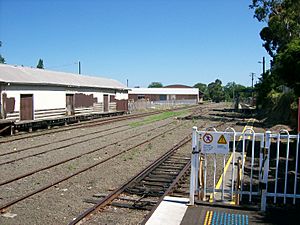
The line then goes south through the Royal National Park and the Illawarra escarpment. It goes downhill to Wollongong. The original route through Helensburgh was changed in 1915. A new Helensburgh station opened on the new route. The line goes through tunnels and towns like Otford, Stanwell Park, and Coalcliff.
South of Coalcliff, the line becomes single track through the Clifton Tunnel. It then becomes double track again near Scarborough. The line continues south through Wollongong's suburbs. Thirroul has a platform where some trains end their journey.
At Coniston, an electric branch line goes east to Port Kembla. At Unanderra, the line to Moss Vale branches off to the west. The line continues south through Kembla Grange Racecourse and Dapto. Dapto was the end of the electric line until 2001.
The line passes through Albion Park to reach Kiama. This is the end of the electric line. South of Kiama, the line is a single, non-electric track. It goes through dairy farms and tunnels to Gerringong and Berry. Finally, it reaches its end at Bomaderry.
Other Railway Lines Connected
The Bankstown Line
The Bankstown line first opened in 1895. It was a branch from the Illawarra Line to Belmore Station. Later, it was extended to connect to the Main South line in 1928.
The East Hills Line
The East Hills Line was suggested in 1916. It opened to Kingsgrove in 1931 and to East Hills later that year. It connected to the Main Southern line in 1987. In 2000, the Airport line opened. This meant most East Hills trains used the new line to get to the city.
The Cronulla Line
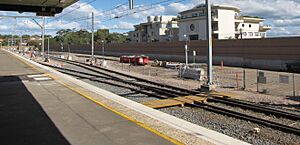
A single-track tram line used to run between Sutherland and Cronulla. It opened in 1911 but closed in 1932. This was because of competition from buses and delays on the tram line.
After the tramway closed, plans for a railway began. There were some delays due to money and where the line would connect. But in 1936, the government approved the line. It opened on 16 December 1939. The new line had five stations.
The Cronulla line was originally single track. To allow more trains, parts of the line were doubled. A 3.5-kilometre section was doubled between Gymea and Caringbah in 1985. The remaining single-track sections were doubled in 2010.
The Royal National Park Line
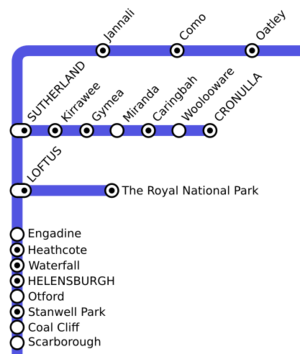
The Royal National Park was created in 1879. A short railway line was built into the park in 1886. It was used for army training and for tourists. The station was first called Loftus. It had two tracks and sidings for goods. Regular tourist services started in May 1886. Part of the line was doubled in 1899 for busy weekends. When the Illawarra Line got electricity in 1926, this branch line was also electrified.
The line continued to serve park visitors for many years. In 1946, a second platform was added for a Scout Jamboree. The station was renamed The Royal National Park in 1955. Over time, fewer people used the line. This was because of new roads and other train lines. Passenger services stopped in 1991 due to problems.
However, the Sydney Tramway Museum was allowed to use the line. They changed it for trams. The line reopened on 1 May 1993. It is now called ParkLink. Trams run on Sundays and public holidays.
The Port Kembla Line
At Coniston, an electric branch line goes east to Port Kembla. It has three stations along the way. This line has two tracks for most of its length. It is used by freight trains and local passenger trains. There is a yard at Port Kembla to store electric trains overnight.
The railway network at Port Kembla was built in 1916. Passenger trains started running to the suburbs in 1920. Stations like Cringila (1926), Port Kembla North (1936), and Lysaghts (1938) were added. Lysaghts station was for workers at the nearby steel plant.
The Unanderra – Moss Vale Line
The Unanderra – Moss Vale line is a railway line that connects to the Illawarra line at Unanderra. It goes west up the Illawarra escarpment. It then joins the Main Southern line at Moss Vale. People first suggested this line in the 1880s. They wanted a connection to the port at Port Kembla. Construction began in 1925, and the line opened in 1932.
What Trains Use the Line?
Passenger services on the South Coast line use electric double-deck trains. These trains run between Bondi Junction or Central and Wollongong, Kiama, or Port Kembla. From Kiama, diesel shuttle trains connect to Bomaderry.
Freight trains mostly carry coal and other goods to and from Port Kembla. However, freight trains are not allowed on the suburban lines during busy times. South of Unanderra, freight trains also serve quarries at Dunmore and Bombo. The only freight trains south of Bombo go to the Manildra Group's starch plant in Bomaderry.


